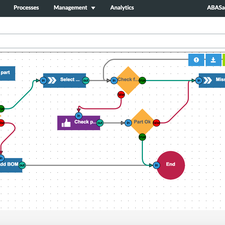Blog
abas ERP Workflow Editor

The Workflow Editor, a solution that allows managers to create new processes that integrate with existing functions in abas ERP, has been upgraded to version 2.0 and underwent several changes to improve user friendliness. The Workflow Editor now allows managers to maintain the users involved in each workflow directly through the plugin itself, rather than having to take additional steps by going through abas ERP. The Workflow Designer also now provides thumbnail images with the list workflows that are in progress, so users can quickly identify which workflow they’re looking for. This eliminates users potentially needing to click into pending workflows to determine which one they’re searching for. Additionally to improve user friendliness, the Workflow Editor now better helps users identify errors when they submit their work by putting the cursor directly in the incomplete box.
One of the Workflow Editor’s most significant changes involves the editing function. Managers will now create a copy of a workflow that is in process to make changes, rather than editing the original model. Then once the changes are completed and validated, the manager can save it and it will update the original file. This eliminates confusion that could previously have occurred if a manager was making several edits to a workflow model as the user was trying to complete it.

Managers can now create a copy of a workflow in progress when they want to make edits without disrupting users from updating their tasks.
Another aspect of the Workflow Editor that has been implemented to increase productivity is the time management function. Managers can now assign a time limit for the completion of a task, which will stabilize productivity and help users prioritize their time. Along with the time management feature ties in the new analytics function, which is a dashboard that analyzes workflow data to show which processes are always late or on time, and which assignments are getting done faster or slower than expected. This allows managers to identify who is best suited for a task so they can re-optimize their workflows to increase productivity. Furthermore, the Workflow Editor now also features an audit trial that traces the activity of current and past workflow processes, displaying how much time they took, who was involved in the process, and what task they performed for its completion.

Managers can now assign time limits with tasks in order to maintain productivity and help users prioritize their time.

The analytics function analyzes workflow data to illustrate how tasks are being completed, so managers can optimize their processes.
In addition to bettering user friendliness and productivity, the Workflow Editor has also been improved to save users time and trouble by creating shortcuts. Users can now create templates with automated tasks that are triggered when a certain action is performed. These automated tasks can be as simple or complex as desired to save users the trouble of going through repetitive steps of the workflow every day.
Check out how we can manage your workflow by visiting our Workflow Management product page for more information.


